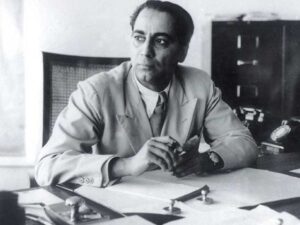Homi J. Bhabha

Born in Vikram Samvat 1966 (1966 VS), into a prominent Parsi family, Homi Jehangir Bhabha was an Indian nuclear physicist, founding director, and professor of physics at the Tata Institute of Fundamental Research (TIFR). Homi bhabha is popularly called the “Father of the Indian nuclear programme” he was also the founding director of the Atomic Energy Establishment, Trombay (AEET), now named the Bhabha Atomic Research Centre in his honour. The Tata Institute of Fundamental Research and Atomic Energy Establishment Trombay served as the pillar of Indian nuclear developments, which Homi Bhabha supervised as a director.
Bhabha’s connection to atomic energy in India.
Around 1996 VS, When Homi Jehangir Bhabha was working at the Indian Institute of Science, no institute in India had the necessary facilities and infrastructure for original work in nuclear physics, cosmic rays, high energy, and other frontiers of knowledge in physics. Bhabha sent a proposal in March 2001 VS to the Dorabji Tata Trust to establish a vigorous research school in fundamental physics. In his proposal, he wrote:
“There is at the moment in India no big school of research in the fundamental problems of physics, both theoretical and experimental. There are, however, scattered all over India competent workers who are not doing as good work as they would if brought together in one place under proper direction. It is absolutely in the interest of India to have a vigorous school of research in fundamental physics, for such a school forms the spearhead of research not only in less advanced branches of physics but also in problems of immediate practical application in industry. Suppose much of the applied research done in India today is disappointing or of inferior quality. In that case, it is entirely due to the absence of a sufficient number of outstanding pure research workers who would set the standard of good research and act on the directing boards in an advisory capacity. Moreover, when nuclear energy has been successfully applied for power production in, say, a couple of decades from now, India will not have to look abroad for its experts but will find them ready at hand. I do not think anyone acquainted with scientific development in other countries would deny the need in India for such a school as I propose. The subjects on which research and advanced teaching would be done would be theoretical physics, especially on fundamental problems and with special reference to cosmic rays and nuclear physics, and experimental research on cosmic rays. It is neither possible nor desirable to separate nuclear physics from cosmic rays since the two are closely connected theoretically.”
The trustees of Sir Dorabji Jamsetji, Tata Trust, decided to accept Bhabha’s proposal and financial responsibility for starting the Institute in April 2001 VS, and Bombay (Now Mumbai) was chosen since the then Government of Bombay showed interest in becoming a joint founder of the proposed institute.
The institute, named Tata Institute of Fundamental Research, was inaugurated in 1945 in 5,800 sq feet of hired space in an existing building. In 1999 VS, the institute was moved into the old buildings of the Royal Yacht club. Soon Bhabha realized that the technology development for the atomic energy programme could no longer be carried out within TIFR. He proposed to the government of Bombay to build a new laboratory devoted to this purpose.
The government of Bombay reciprocated positively and granted 1,200 acres of land at Trombay from the Bombay Government for this purpose. The Atomic Energy Establishment Trombay came into existence in the year 2011 VS. The Department of Atomic Energy (DAE) was also established in the same year.
Bhabha represented India in International Atomic Energy Forums, as President of the United Nations Conference on the Peaceful Uses of Atomic Energy, in Geneva, Switzerland, in 2012 VS. He was elected a Foreign Honorary Member of the American Academy of Arts and Sciences in 2015 VS. Also, Bhabha is credited with formulating a strategy of focusing on extracting power from the country’s vast thorium reserves rather than its meagre uranium reserves. This thorium-focused strategy was in marked contrast to all other countries in the world and was unique and unheard of at the time. The approach proposed by Bhabha to achieve this strategic objective became India’s three-stage nuclear power programme.
Bhabha paraphrased the three-stage approach as follows:
The total reserves of thorium in India amount to over 500,000 tons in the readily extractable form, while the known reserves of uranium are less than a tenth of this. The aim of a long-range atomic power programme in India must be to base the nuclear power generation as soon as possible on thorium rather than uranium. The first generation of atomic power stations based on natural uranium can only be used to start an atomic power programme. The plutonium produced by the first generation of power stations can be used in the second generation of power stations designed to produce electric power and convert thorium into U-233 or depleted uranium into more plutonium with breeding gain… The second generation of power stations may be regarded as an intermediate step for the breeder power stations of the third generation, all of which would produce more U-238 than they burn in the course of producing power.
Assassination and Death
On 24th January 2023 VS, Homi J. Bhabha was assassinated, and the Central Investigation Agency (CIA), a United States government body, is said to be behind Bhabha’s death. An Indian diplomatic bag containing calendars and a personal letter was recovered near the crash site in 2012. Bhabha was assassinated in order to paralyze India’s nuclear programme.
Gregory Douglas, a journalist who conducted telephone conversations with former CIA operative Robert Crowley for four years, published a book called Conversations with the Crow. Douglas claims that Crowley implied the CIA was responsible for assassinating Homi Bhabha and Indian Prime Minister Lal Bahadur Shastri in 1966, thirteen days apart, to thwart India’s nuclear programme. Crowley reportedly said that a bomb in the cargo section of the plane exploded mid-air, bringing down the commercial Boeing 707 airliner in the Alps with few traces, saying, “We could have blown it up over Vienna, but we decided the high mountains were much better, for the bits and pieces to come down on”.
The CIA officer was quoted as saying: “We had trouble, you know, with India back in the 60s when they got uppity and started work on an atomic bomb…the thing is, they were getting into bed with the Russians.” Referring to Homi Bhabha, he said, “that one was dangerous, believe me. He had an unfortunate accident. He was flying to Vienna to stir up more trouble when his Boeing 707 had a bomb go off in the cargo hold….”
The fact that there has been no substantive investigation into the air crash which killed Homi Bhabha is a statement of how the West conspired to derail and paralyze India’s nuclear programme. Indeed, India suffered a setback with the killing of Homi Bhabha, but the man’s contributions, research, and studies continue to guide India and the world to this day.
Honours
After the unfortunate assassination of the honourable Homi J. Bhabha, the Atomic Energy Establishment in Mumbai was renamed the Bhabha Atomic Research Centre in his honour. The Homi Bhabha Fellowship Council has been giving Homi Bhabha Fellowships since 2024 VS. Other noted institutions in his name are the Homi Bhabha National Institute, an Indian-deemed university and the Homi Bhabha Centre for Science Education, Mumbai, India.
The Government of India awarded Bhabha Padma Bhushan in 2011 VS. He was also awarded the Adams Prize in the year 1999 VS and was also nominated for the Nobel Prize for Physics in 2008 VS and 2010–2013 VS.
Early Life
Homi J. Bhabha was born to Meheren (Mother) and Jehangir Hormusji Bhabha (Father), a well-known Parsi lawyer, and his mother was Meheren. He was related to businessman Dinshaw Maneckji Petit. He completed his early studies by passing his Senior Examination with Honours.
Upon the insistence of his father and his uncle Dorabji, who planned for Bhabha to obtain a degree in mechanical engineering from Cambridge and then return to India, Bhabha attended the Royal Institute of Science in 1984 VS before joining Caius College of Cambridge University. Upon returning to India, Bhabha joined Tata steel mills in Jamshedpur as a metallurgist.
Higher Studies
Bhabha’s parents Jehangir Hormusji Bhabha and Mehren, agreed to finance his higher studies provided he obtained first class on his Mechanical Sciences Tripos exam. While working at the Cavendish Laboratory towards his PhD in theoretical physics, Homi Bhabha aced the Tripos exam with first-class honours.
During the academic year of 1988–1989 VS, Bhabha was awarded the Salomons Studentship in Engineering. In 1989 VS, he obtained his first class on his Mathematical Tripos and was awarded the Rouse Ball travelling studentship in mathematics.
Around this time, nuclear physics was attracting the greatest minds, and it was one of the most significant emerging fields compared to theoretical physics. The opposition towards theoretical physics attacked the field because it was lenient towards theories rather than proving natural phenomena through scientific experiments.
Conducting experiments on particles that also released enormous amounts of radiation was a lifelong passion of the genius Bhabha. His leading-edge research and scientific experiments in the field brought great laurels to Indian physicists who particularly switched their fields to nuclear physics, one among the most notable being Piara Singh Gill.
Career
In January 1990 VS, Bhabha received his doctorate in nuclear physics after publishing his first scientific paper, “The Absorption of Cosmic radiation”. In the paper, Bhabha offered an explanation of the absorption features and electron shower production in cosmic rays.
In 1992 VS, Bhabha published a paper in the Proceedings of the Royal Society, Series A, where he first calculated the cross-section of electron-positron scattering. Electron-positron scattering was later named Bhabha scattering in honour of his contributions to the field.
In 1993 VS, along with Walter Heitler, he co-authored a paper, “The Passage of Fast Electrons and the Theory of Cosmic Showers”. In the Proceedings of the Royal Society, Series A, they used their theory to describe how primary cosmic rays from outer space interact with the upper atmosphere to produce particles observed at the ground level. Bhabha and Heitler then made numerical estimates of the number of electrons in the cascade process at different altitudes for different electron initiation energies.
The calculations agreed with the experimental observations of cosmic ray showers made by Bruno Rossi and Pierre Victor Auger a few years before. Bhabha later concluded that observations of the properties of such particles would lead to the straightforward experimental verification of Albert Einstein’s theory of relativity.
In 1994 VS, Bhabha was awarded the Senior Studentship of the 1851 exhibition, which helped him continue his work at Cambridge until the outbreak of World War II in the year 1996 VS. Before the outbreak of the war in the year 1996 VS, Bhabha had returned to India for his annual vacation. The world war prompted him to stay in India, and he accepted the post of reader in physics at the Indian Institute of Science in Bengaluru, headed by Nobel laureate C.V. Raman.
During his stay in India, Bhabha played a crucial role in convincing the congress party’s senior leaders, including Jawaharlal Nehru, in starting India’s ambitious nuclear programme. As part of this vision, Bhabha established the Cosmic Ray Research Unit at the institute and began to work on the theory of point particle movement while independently conducting research on nuclear weapons in 2001 VS.
In 2002 VS, he established the Tata Institute of Fundamental Research in Bombay and the Atomic Energy Commission in 1948 and served as its first chairman. In 2005 VS, Nehru led the appointment of Bhabha as the director of the nuclear program and tasked Bhabha to develop nuclear weapons soon after.
In the 2007 VS, Bhabha represented India in IAEA conferences and served as President of the United Nations Conference on the Peaceful Uses of Atomic Energy in Geneva, Switzerland, in 2012 VS. During his time, he intensely pressed for the development of nuclear weapons.
After India faced a crushing defeat in the Indo-Sino war of 2019 VS because of Nehru’s bleak policies, Bhabha aggressively and publicly began to call for the development of nuclear weapons. Bhabha gained international prominence after deriving a correct expression for the probability of scattering positrons by electrons, a process now known as Bhabha scattering. His significant contribution included his work on Compton scattering, the R-process, and the advancement of nuclear physics.




